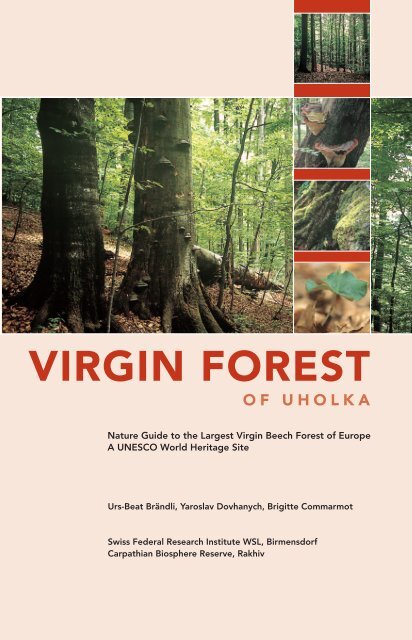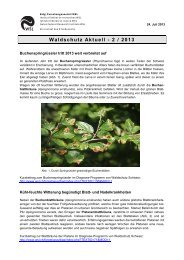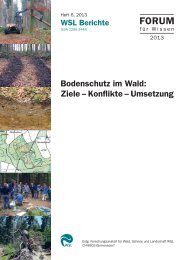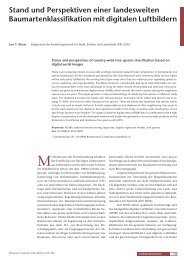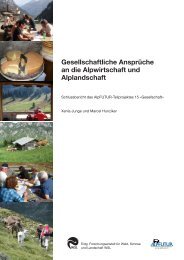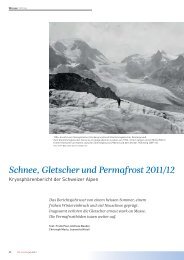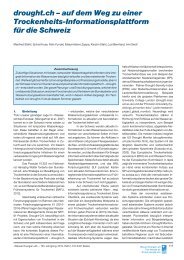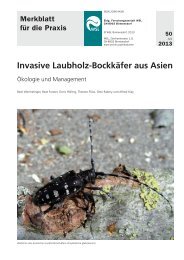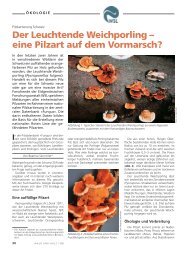Nature Guide to the Largest Virgin Beech Forest - WSL
Nature Guide to the Largest Virgin Beech Forest - WSL
Nature Guide to the Largest Virgin Beech Forest - WSL
You also want an ePaper? Increase the reach of your titles
YUMPU automatically turns print PDFs into web optimized ePapers that Google loves.
VIRGIN FOREST<br />
OF UHOLKA<br />
<strong>Nature</strong> <strong>Guide</strong> <strong>to</strong> <strong>the</strong> <strong>Largest</strong> <strong>Virgin</strong> <strong>Beech</strong> <strong>Forest</strong> of Europe<br />
A UNESCO World Heritage Site<br />
Urs-Beat Brändli, Yaroslav Dovhanych, Brigitte Commarmot<br />
Swiss Federal Research Institute <strong>WSL</strong>, Birmensdorf<br />
Carpathian Biosphere Reserve, Rakhiv
Citation: Brändli, U.-B.; Dovhanych, Y.; Commarmot,<br />
B., 2008: <strong>Virgin</strong> <strong>Forest</strong>s of Uholka. <strong>Nature</strong><br />
<strong>Guide</strong> <strong>to</strong> <strong>the</strong> <strong>Largest</strong> <strong>Virgin</strong> <strong>Beech</strong> <strong>Forest</strong> of<br />
Europe. A UNESCO World Heritage Site. <strong>WSL</strong>,<br />
Birmensdorf and CBR, Rakhiv.<br />
Translation: Silvia Dingwall, Vic<strong>to</strong>ria Hubko<br />
Layout and Copyright © 2008 by Swiss Federal<br />
Research Institute <strong>WSL</strong>, Birmensdorf, Switzerland<br />
Printed in Ukraine, “Colorove Nebo”, Lviv<br />
Available from: Carpathian Biosphere Reserve<br />
CBR, Krasne Pleso Street 77, P. O. Box - 8,<br />
UA-90600 Rakhiv, Ukraine<br />
Tel: +380 3132 221 93, cbr@rakhiv.net.ua<br />
P<br />
Atlantic<br />
Ocean<br />
E<br />
0°<br />
IS<br />
IRL<br />
GB<br />
AND<br />
F<br />
North Sea<br />
NL<br />
B<br />
L<br />
CH<br />
Mediterranean Sea<br />
DK<br />
D<br />
FL<br />
12°<br />
N<br />
I<br />
A<br />
CZ<br />
SLO<br />
HR<br />
M<br />
S<br />
Baltic Sea<br />
The contents of this booklet are based on:<br />
Brändli, U.-B.; Dowhanytsch, J. (Red.) 2003: Urwälder<br />
im Zentrum Europas. Ein Naturführer<br />
durch das Karpaten-Biosphärenreservat in der<br />
Ukraine. <strong>WSL</strong> Birmensdorf; CBR Rachiw. Bern,<br />
Stuttgart, Wien, Haupt. 192 Seiten.<br />
Pho<strong>to</strong>s (pages): Peter Baumann/Sutter (9ar), Urs-<br />
Beat Brändli (1b, 2b, 3b, 5a, 8br, 13b, 15a, 16b, 18b),<br />
Heisler and Mellon (1a), Thielemann/Sutter (6a),<br />
Damien Hubaut/Sutter (2a), Ivan Shelever (1t, 3a,<br />
4b, 5t, 5b, 8a, 8bl, 9al, 9bl, 9br,12, 13t, 13al, 13ar, 14<br />
all, 15b, 17all, 18a, 20a, cover), Eric Baccega/ Sutter<br />
(6b), Michel Watelet/Sutter (7a), Beat Wermelinger<br />
(7b), Michel Luquet/Sutter (19ar), Rolf Kopfle/<br />
Sutter (19br), Daniel Hubacher/Sutter (20b)<br />
t = <strong>to</strong>p; a = above; b = below; m = mid; l = left;<br />
r = right<br />
PL<br />
SK<br />
H<br />
LT<br />
FIN<br />
EST<br />
LV<br />
RO<br />
BY<br />
BIH<br />
SCG<br />
BG<br />
MK<br />
AL<br />
GR<br />
24°<br />
MD<br />
UA<br />
Black Sea<br />
RUS<br />
0 250 500 km<br />
36°<br />
64°<br />
56°<br />
48°<br />
40°
VIRGIN FORESTS IN THE HEART OF<br />
EUROPE<br />
Some regions are significant because of <strong>the</strong>ir<br />
geographical location. One such region is<br />
Transcarpathia, in <strong>the</strong> south-westernmost<br />
corner of Ukraine in <strong>the</strong> geographical centre<br />
of Europe. The prefix “Trans-” refers <strong>to</strong> <strong>the</strong><br />
fact that <strong>the</strong> region is not on <strong>the</strong> Kyiv side of<br />
<strong>the</strong> Carpathian Mountains but across <strong>the</strong> range<br />
on <strong>the</strong> o<strong>the</strong>r side. Transcarpathia borders on<br />
Romania, Hungary, <strong>the</strong> Slovak Republic and<br />
Poland. For many centuries it was part of <strong>the</strong><br />
Hungarian, Austrian and Austro-Hungarian<br />
kingdoms. Its national allegiance changed six<br />
times during <strong>the</strong> 20 th century alone. The area<br />
has always had close relationships with its<br />
western neighbours.<br />
Exploitation of <strong>the</strong> forest started late<br />
and protection early<br />
Transcarpathia’s location between East and<br />
West has affected settlement in <strong>the</strong> region and<br />
<strong>the</strong> use of <strong>the</strong> forest. The region’s borders<br />
changed so frequently over <strong>the</strong> centuries that<br />
VIRGIN FOREST OF UHOLKA<br />
Rafting timber in Transcarpathia (1945)<br />
industrialization and intensive forest use set in<br />
relatively late. For centuries much of <strong>the</strong><br />
mountain forest remained un<strong>to</strong>uched. Not<br />
until <strong>the</strong> 18 th century were German emigrants<br />
and Austrian woodcutters settled <strong>the</strong>re by <strong>the</strong><br />
Habsburgs. Timber from conifers was rafted<br />
down <strong>the</strong> larger rivers. Remote beech forests,<br />
like Uholka or mountain forests without any<br />
suitable water stretches for rafting, were spared<br />
for a long time, sometimes even until well in<strong>to</strong><br />
<strong>the</strong> 20 th century. O<strong>the</strong>r mountain forests were<br />
kept as royal hunting grounds and not used for<br />
timber. The first forest reserve was established<br />
in Transcarpathia in 1908.<br />
The “Jugendstil” houses in Uzhorod, <strong>the</strong> capital of Transcarpathia, are indica<strong>to</strong>rs of <strong>the</strong> Austro-Hungarian influence<br />
1
2<br />
Black woodpecker (Dryocopus martius)<br />
These ra<strong>the</strong>r special circumstances have made<br />
it possible for extensive remnants of virgin<br />
forest <strong>to</strong> persist in Transcarpathia until <strong>to</strong>day.<br />
Most of <strong>the</strong>se primeval forests, which in <strong>to</strong>tal<br />
cover 14,600 ha, are now protected within <strong>the</strong><br />
Carpathian Biosphere Reserve (CBR).<br />
Unique virgin forests<br />
The virgin forests of Transcarpathia constitute<br />
a natural heritage of global significance. This<br />
is especially true for <strong>the</strong> approx. 8800 ha of<br />
virgin forest in <strong>the</strong> “Uholsko-Shyrokoluzhan -<br />
skyi Massif”, which is thought <strong>to</strong> be <strong>the</strong> largest<br />
virgin forest of European beech. The remain -<br />
ing extensive primeval forests in Europe are<br />
mainly in <strong>the</strong> east and south-east of <strong>the</strong> continent,<br />
apart from <strong>the</strong> coniferous forests in <strong>the</strong><br />
north. Most European primeval forests are no<br />
larger than 50–100 ha. Continuous areas of<br />
1000 ha, and more especially of broadleaved<br />
forest, are very rare. In 2007 <strong>the</strong> primeval<br />
beech forests of <strong>the</strong> Carpathians (Slovakia,<br />
Ukraine) were added <strong>to</strong> UNESCO’S World<br />
Heritage list.<br />
<strong>Virgin</strong> forests are vital for both humans and<br />
nature. They provide us with opportunities <strong>to</strong><br />
investigate <strong>the</strong> natural structure, biological<br />
diversity, genetic structure and natural pro -<br />
cesses in undisturbed forests. Findings from<br />
studying virgin forests can benefit <strong>the</strong> nearnatural<br />
management of exploited forests.
The Carpathian Biosphere Reserve<br />
The CBR is one of <strong>the</strong> largest and most<br />
important protected areas in Ukraine. It was<br />
designated a UNESCO Biosphere Reserve in<br />
1992. This shows how much UNESCO<br />
appreci ated <strong>the</strong> efforts and achievements of<br />
<strong>the</strong> CBR in conserving biodiversity and promoting<br />
sustainable development in <strong>the</strong> region.<br />
Besides protecting <strong>the</strong> remaining patches of<br />
<strong>the</strong> original natural ecosystems, one of <strong>the</strong><br />
most important objectives of <strong>the</strong> CBR is <strong>to</strong><br />
provide access, albeit limited, for visi<strong>to</strong>rs and<br />
<strong>to</strong> enable <strong>the</strong>m <strong>to</strong> see <strong>the</strong> enchanting beauty of<br />
this unspoilt natural area with <strong>the</strong>ir own eyes.<br />
The CBR is made up of 8 isolated regional<br />
units (massifs) located in different districts of<br />
Transcarpathia (see map, page 10). These re -<br />
present all <strong>the</strong> natural and climatic zones of <strong>the</strong><br />
Ukrainian Carpathians within <strong>the</strong> reserve. The<br />
lowest point of <strong>the</strong> reserve is in <strong>the</strong> Narcissi<br />
Valley at an altitude of 170 m asl. The highest<br />
point is Mt. Hoverla (2061 m asl), which is<br />
Ukraine’s highest summit. The reserve covers<br />
a <strong>to</strong>tal area of 53,630 ha.<br />
VIRGIN FOREST OF UHOLKA<br />
A trip <strong>to</strong> <strong>the</strong> Narcissi Valley near Khust is especially worthwhile during <strong>the</strong> flowering season in April and May<br />
The administrative offices of <strong>the</strong> CBR are<br />
located in <strong>the</strong> <strong>to</strong>wn of Rakhiv, where <strong>the</strong>re is a<br />
small museum with information on <strong>the</strong> natural<br />
and cultural his<strong>to</strong>ry of <strong>the</strong> region.<br />
The Church of St.Nicholas (Mykolaivska Church) was<br />
built in 1470 and is one of <strong>the</strong> oldest maintained<br />
wooden churches in Transcarpathia. It is in Kolodne<br />
along <strong>the</strong> road <strong>to</strong> Uholka.<br />
3
4<br />
UHOLKA – PEARL OF THE CARPA-<br />
THIANS<br />
Uholka, <strong>the</strong> area we recommend you visit, is in<br />
<strong>the</strong> sou<strong>the</strong>rn part of <strong>the</strong> “Uholsko-Shyrokoluzhanskyi<br />
Massif”. This massif covers around<br />
16,000 ha, and is in <strong>the</strong> central part of Transcarpathia,<br />
north of <strong>the</strong> <strong>to</strong>wn of Tyachiv (see<br />
map, page 10). It has been protected since<br />
1920. In <strong>the</strong> virgin forest of Uholka visi<strong>to</strong>rs can<br />
go on two fascinating round trips. We describe<br />
<strong>the</strong>se here, <strong>to</strong>ge<strong>the</strong>r with some extra infor -<br />
mation about <strong>the</strong> area’s natural environment.<br />
Sights and site conditions<br />
Uholka’s virgin beech forests consitute <strong>the</strong><br />
region’s most valuable treasure. Here beech<br />
trees grow well in <strong>the</strong> fresh, and slightly damp,<br />
fertile soil under optimal ecological con -<br />
ditions. Trees can be as much as 140 cm in dia -<br />
meter, and as tall as 46 m. Most of <strong>the</strong> forests<br />
are on hillsides with 15–30 degree slopes, at<br />
altitudes of 400–1350 m asl. The climate of<br />
Uholka is mild, with mean temperatures in<br />
July over 17 °C, and in January around -4 °C.<br />
Annual precipitation is about 950 mm.<br />
River Mala Uholka<br />
The massif consists mostly of flysch layers with<br />
marls and sands<strong>to</strong>ne, and of jurassic limes<strong>to</strong>ne<br />
and cretaceous conglomerates. A very special<br />
feature of Uholka is <strong>the</strong> presence of numerous<br />
limes<strong>to</strong>ne cliffs and karst caves. Uholka contains<br />
roughly half of <strong>the</strong> about 60 karst caves<br />
found in <strong>the</strong> Ukrainian Carpathians, including<br />
one famous cave, “Druzhba” (Friendship),<br />
which is <strong>the</strong> largest in <strong>the</strong> Ukrainian Carpathians.<br />
Uholka’s main landmark is, however, <strong>the</strong><br />
“Karst Bridge”, a kind of natural rocky arch,<br />
which has fascinated people for centuries.<br />
The numerous mineral springs are also well<br />
known and popular.<br />
<strong>Forest</strong> types<br />
Once <strong>the</strong> beech has established itself in an<br />
optimal location like Uholka, no o<strong>the</strong>r tree<br />
species can compete with this shade-<strong>to</strong>lerant<br />
tree. Pure beech forests dominate and comprise<br />
97 % of <strong>the</strong> <strong>to</strong>tal area of primeval forest<br />
in Uholka. The main forest associations are<br />
Fagetum dentariosum and F. asperulosum,<br />
which are very productive and contain some of<br />
<strong>the</strong> tallest beeches in Ukraine.
<strong>Beech</strong> and book<br />
The Ukrainian name for <strong>the</strong> Cyrillic alphabet<br />
– “azbuka” – is directly connected with <strong>the</strong><br />
beech tree (beech = “buk” in Ukrainian), as<br />
are some o<strong>the</strong>r derived words, such as “bukva”<br />
(letter) and “bukvar” (book for teaching <strong>the</strong><br />
alphabet). The German words “Buchstabe”<br />
(letter) and “Buch” (book) also take <strong>the</strong>ir<br />
roots from this tree species.<br />
On warmer sites, <strong>the</strong>re are also mixed beech<br />
forests, such as sessile oak-beech and hornbeam-beech<br />
forests. At higher altitudes you<br />
will find sycamore-beech forests on damp<br />
sites. Grey alder woods grow along Uholka’s<br />
rivers. O<strong>the</strong>r tree species that can be found in<br />
Uholka are ash, wych elm, broad-leaved lime,<br />
yew and juniper.<br />
In some areas, such as Hrebin and Mala<br />
Kopytsya, a number of relic phy<strong>to</strong>coenoses<br />
have been preserved. For example, it is <strong>the</strong><br />
only habitat for beech-lime forest with Sesleria<br />
(Fage<strong>to</strong>-Tiliaetum sesleriosum) in Ukraine.<br />
You can also find natural yew-beech forests<br />
sporadically growing on limes<strong>to</strong>ne slopes.<br />
Characteristics of virgin beech forests<br />
The most striking and impressive features of<br />
<strong>the</strong>se forests are <strong>the</strong> mighty beeches, <strong>the</strong> broken-off<br />
tree stems covered with fungi and <strong>the</strong><br />
VIRGIN FOREST OF UHOLKA<br />
decaying trunks of fallen trees. The proportion<br />
of standing and lying dead wood in Uholka<br />
amounts <strong>to</strong> 15% of <strong>the</strong> <strong>to</strong>tal volume of wood.<br />
In managed forests <strong>the</strong> proportion of dead<br />
wood is usually under 2%.<br />
In managed forests beeches are normally harvested<br />
when <strong>the</strong>y are around 100 <strong>to</strong> 150 years,<br />
i.e. well before <strong>the</strong>y reach <strong>the</strong>ir natural age<br />
limit. That is why you hardly ever find giant<br />
trees in <strong>the</strong>se forests and <strong>the</strong>ir stem diameters<br />
are rarely more than a metre. Uholka’s beeches,<br />
however, can grow <strong>to</strong> be about 250 years old<br />
before <strong>the</strong>y die and start <strong>to</strong> gradually decompose<br />
or are blown down, creating small gaps.<br />
These are normally <strong>the</strong>n quickly covered with<br />
young beech seedlings. Only where a group of<br />
trees have been uprooted at <strong>the</strong> same time is it<br />
possible for a few light-demanding tree species<br />
like maple or ash <strong>to</strong> grow.<br />
Inhabitants of <strong>the</strong>se undisturbed forests<br />
There are around 1000 brown bears (Ursus<br />
arc<strong>to</strong>s), 500 wolves (Canis lupus) and 400 lynx<br />
(Lynx lynx) living in <strong>the</strong> Ukrainian Carpa -<br />
thians. O<strong>the</strong>r important carnivores in Trans-<br />
The redbelt (Fomi<strong>to</strong>psis pinicola) is a perennial pore<br />
fungi with a resinous surface that is combustible.<br />
5
6<br />
S<strong>to</strong>ck dove (Columba oenas)<br />
The lynx<br />
By <strong>the</strong> beginning of <strong>the</strong> 20 th century <strong>the</strong> lynx<br />
(Lynx lynx) had been almost completely eradi -<br />
cated in most of Western Europe. Today <strong>the</strong><br />
Carpathians are home <strong>to</strong> one of Europe’s few<br />
viable lynx populations. Animals from this group<br />
carpathia are <strong>the</strong> wild cat (Felix silvestris), <strong>the</strong><br />
otter (Lutra lutra) and a very special animal,<br />
<strong>the</strong> European mink (Mustela lutreola).<br />
One typical forest-dweller here is <strong>the</strong> black<br />
s<strong>to</strong>rk (Ciconia nigra). Two or three couples<br />
nest in Uholka every year. This bird can only<br />
be found naturally in undisturbed old forests,<br />
which is why it is now rare worldwide. Ano<strong>the</strong>r<br />
endangered forest bird is <strong>the</strong> eagle-owl (Bubo<br />
bubo) – <strong>the</strong> largest owl in <strong>the</strong> Carpathian<br />
forests.<br />
Dead wood specialists<br />
Old trees and dead wood are important habitats<br />
for many typical forest species. Without<br />
dead wood, many types of fungi, moss, lichen<br />
and insects would have no basis for existence.<br />
Uholka’s virgin forests provide a paradise for<br />
are used in re-introduction programmes in places<br />
like <strong>the</strong> Alps and <strong>the</strong> Balkans. The lynx is a shy<br />
creature. A single animal can have a terri<strong>to</strong>ry as<br />
large as 170 square kilometres and is thus seldom<br />
seen.
Black s<strong>to</strong>rk (Ciconia nigra)<br />
dead-wood insects, woodpeckers, bats and<br />
o<strong>the</strong>r tree-hole dwellers, like <strong>the</strong> s<strong>to</strong>ck dove<br />
(Columba oenas). All of Europe’s ten varieties<br />
of woodpecker can be found in Transcarpathia.<br />
<strong>Virgin</strong> forests full of dead wood play a very<br />
important role in maintaining species diversity.<br />
In <strong>the</strong>m you can find rare insects like <strong>the</strong><br />
hermit beetle (Osmoderma eremita), <strong>the</strong> stag<br />
beetle (Lucanus cervus), <strong>the</strong> Alpine longicorn<br />
beetle Rosalia (Rosalia alpina) and <strong>the</strong> great<br />
Capricorn beetle (Cerambyx cerdo), which are<br />
all dead-wood dwellers, but also rare butterflies<br />
like <strong>the</strong> Tau emperor (Aglia tau).<br />
The high proportion of dead wood in Uholka’s<br />
virgin forests means that <strong>the</strong>y contain a much<br />
richer variety of fungi than a managed forest.<br />
Species like <strong>the</strong> coral <strong>to</strong>oth fungus (Hericium<br />
coralloides) or Dentipellis fragilis both depend<br />
on old forests and are still relatively frequent<br />
in Uholka. In Switzerland, however, <strong>the</strong>y are<br />
on <strong>the</strong> Red List of endangered fungi.<br />
VIRGIN FOREST OF UHOLKA<br />
Night flyers<br />
Uholka can also be called “a bat kingdom” as<br />
it is full of hollow trees and karst holes. Hollow<br />
trees provide homes for bats mostly in summer,<br />
but in winter <strong>the</strong>y are <strong>to</strong>o cold for most<br />
bats. A few species, however, do hibernate in<br />
tree hollows <strong>to</strong>o. Caves in Uholka shelter<br />
about 2000 bats belonging <strong>to</strong> 15 different<br />
The larva of <strong>the</strong> Alpine longicorn beetle Rosalia (Rosalia<br />
alpina) usually develops in beech wood<br />
7
8<br />
Greater mouse-eared bat (Myotis myotis)<br />
Entrance <strong>to</strong> <strong>the</strong> “Hrebin” Cave<br />
species. Nine of <strong>the</strong>m are rare, including <strong>the</strong><br />
greater mouse-eared bat (Myotis myotis),<br />
Natterer's bat (Myotis nattereri) and <strong>the</strong> Brown<br />
long-eared bat (Plecotus auritus), which are<br />
extremely endangered throughout Europe.<br />
Ancient life in caves<br />
The living conditions in <strong>the</strong> caves have re -<br />
mained practically unchanged until <strong>to</strong>day,<br />
enabling a number of ancient fauna species <strong>to</strong><br />
continue <strong>to</strong> inhabit <strong>the</strong>m. The isolation of<br />
<strong>the</strong>se habitats, however, has prevented many<br />
of <strong>the</strong>se species from spreading far from <strong>the</strong>ir<br />
particular caves. The carabid beetle Duvalius<br />
transcarpaticus Shill. et Riz is one such<br />
species. It is found exclusively in <strong>the</strong> caves of<br />
<strong>the</strong> Uholka-Shyrokyi Luh Massif. This paleyellow<br />
insect is about 5 mm long and com -<br />
pletely blind. Its menu consists of springtails<br />
(Collembola) of which <strong>the</strong>re are also a large<br />
number of special cave species. A previously<br />
unknown Collembola was discovered in <strong>the</strong><br />
Druzhba Cave in 1996 and named Willemia<br />
virae Kaprus.<br />
Some like it wet<br />
Uholka is home <strong>to</strong> a unique kind of fauna not<br />
found anywhere outside <strong>the</strong> Carpathians,<br />
namely <strong>the</strong> Carpathian newt (Triturus montandoni).<br />
It is endemic in <strong>the</strong> Carpathians and<br />
belongs <strong>to</strong> <strong>the</strong> caudate amphibians. Ano<strong>the</strong>r<br />
species of caudate amphibian is <strong>the</strong> fire salamander<br />
(Salamandra salamandra), whose<br />
bright yellow-black colouring makes it very<br />
The Carpathian blue slug (Bielzia coerulans)
Carpathian newt (Triturus montandoni)<br />
easily recognizable. The large forest keelback<br />
slug Bielzia (Bielzia coerulans) is strikingly<br />
rainbow-like with its green, blue and violet<br />
colouring. During <strong>the</strong> spawning season, <strong>the</strong> Danube<br />
salmon (Hucho hucho), one of Europe’s<br />
most endangered fish species, moves upstream<br />
from <strong>the</strong> River Tisza <strong>to</strong> rivers and streams.<br />
Along <strong>the</strong> rivers you may well spot a dipper<br />
(Cinclus cinclus) sitting on a rock or diving.<br />
Profuse spring flora<br />
<strong>Beech</strong> forests have a thick closed canopy<br />
through which little light penetrates <strong>to</strong> reach<br />
<strong>the</strong> forest floor. They <strong>the</strong>refore do not usually<br />
contain many shrubs. The herbal layer consists<br />
mostly of early flowering plants that often<br />
form carpets of flowers in spring before <strong>the</strong><br />
beech trees are in leaf: yellow wood anemones<br />
(Anemone ranunculoides), <strong>the</strong> bittercress<br />
(Cardamine glanduligera), snowdrops (Galanthus<br />
nivalis), honesty (Lunaria rediviva)<br />
and spring fumewort (Corydalis solida).<br />
VIRGIN FOREST OF UHOLKA<br />
Aurochs’ <strong>to</strong>ngue<br />
The hart’s <strong>to</strong>ngue (Phyllitis scolopendrium) is<br />
known here as aurochs’ <strong>to</strong>ngue. This nomenclature,<br />
like that of some place names in <strong>the</strong> region,<br />
goes back <strong>to</strong> <strong>the</strong> time when <strong>the</strong>re were still herds<br />
of aurochs (Bos primigenius) grazing in Transcarpathia.<br />
This ancient type of cow was common<br />
in <strong>the</strong> region until <strong>the</strong> 15 th century, and became<br />
extinct in 1627. The last specimens lived in <strong>the</strong><br />
forests of Eastern Europe.<br />
About 500 species of vascular plants grow in<br />
Uholka. 30 of <strong>the</strong>m are regarded as rare in<br />
Ukraine, including some endangered species<br />
like: deadly nightshade (Atropa bella-donna),<br />
moonwort (Botrychium lunaria), white helleborine<br />
(Cephalantera damasonium), spring<br />
crocus (Crocus vernus ssp. vernus), dog<strong>to</strong>oth<br />
violet (Erythronium dens-canis), plum-scented<br />
iris (Iris graminea), Russian belladonna (Scopolia<br />
carniolica) and Viola alba. One new<br />
species has been discovered in <strong>the</strong> area, <strong>the</strong><br />
Transcarpathian bedstraw (Galium transcarpaticum).<br />
A rare hellebore (Helleborus purpurascens) Yellow wood anemone (Anemone ranunculoides)<br />
9
10<br />
UZHHOROD<br />
Velykyy<br />
Bereznyy<br />
Perechny<br />
20 km<br />
Berehovo<br />
Carpathian<br />
Biosphere Reserve CBR<br />
in Transcarpathia<br />
Mukachevo<br />
The Uholsko-<br />
Shyrokoluzhanskyi Massif<br />
5 km<br />
1 = The Mala Uholka Trail<br />
2 = The Velyka Uholka Trail<br />
A = Narcissi Valley<br />
B = Kolodne’s wooden church<br />
A<br />
Svalyava<br />
Irshava<br />
Vynohradiv 7<br />
8<br />
Volovets<br />
Khust 6<br />
Tyza<br />
B<br />
Kolodne<br />
Mizhhirya<br />
Tyachiv<br />
Mala<br />
Uholka<br />
1<br />
1 2<br />
5<br />
Yasinya<br />
2<br />
Rakhiv<br />
Massifs of <strong>the</strong> CBR: 3 Chornohirskyi 6 Narcissi Valley<br />
1 Uholsko-Shyrokoluzhanskyi 4 Maramoroskyi 7 Chorno Hora<br />
2 Svydovetskyi 5 Kuziyskyi 8 Yulivska Hora<br />
4<br />
3
The Mala Uholka Trail<br />
The Velyka Uholka Trail<br />
VIRGIN FOREST OF UHOLKA<br />
“Chur”<br />
The Karst Bridge<br />
The “Druzhba” karst cave<br />
Administrative building<br />
Molochnyi Kamin<br />
Hut shelter<br />
Farmhouses<br />
Checkpoint<br />
Rocks<br />
11
12<br />
THE MALA UHOLKA HIKING TRAIL<br />
This circular trail leads through primeval<br />
beech forests passing by caves and limes<strong>to</strong>ne<br />
rocks on <strong>the</strong> way up <strong>to</strong> <strong>the</strong> Karst Bridge. The<br />
trail is about 5 km long, with 500 m difference<br />
in altitude. The whole trail takes about 2<br />
hours. The best time for visiting is from April<br />
<strong>to</strong> Oc<strong>to</strong>ber.<br />
Start in Kicherely<br />
410 m asl<br />
The trail begins at <strong>the</strong> office of <strong>the</strong> Carpathian<br />
Biosphere Reserve (CBR) in Kitcherely, on<br />
<strong>the</strong> nor<strong>the</strong>rn outskirts of <strong>the</strong> village of Mala<br />
Uholka. One kilometer down <strong>the</strong> Mala Uholka<br />
River you can visit a working water mill with a<br />
100-year-old wheel made of oak. Cross <strong>the</strong><br />
river near <strong>the</strong> office and go past <strong>the</strong> former<br />
hunting lodge of a local count, which <strong>to</strong>day is<br />
used as a school.<br />
The Druzhba Cave<br />
400 m from start, 500 m asl<br />
Only 400 m from <strong>the</strong> beginning of <strong>the</strong> trail you<br />
will find on <strong>the</strong> edge of <strong>the</strong> forest one of <strong>the</strong><br />
most interesting sites in Uholka: <strong>the</strong> karst cave<br />
called “Druzhba” (friendship). The entrance<br />
<strong>to</strong> this cave is via a well 2.5 m in diameter and<br />
22 m deep. It leads <strong>to</strong> a great underground hall<br />
decorated with drips<strong>to</strong>nes. A whole system of<br />
corridors leads out of <strong>the</strong> hall, <strong>to</strong>talling 1 km<br />
in length. Access <strong>to</strong> <strong>the</strong> cave is only possible<br />
with special speleological equipment. Tourists<br />
need a permit <strong>to</strong> visit it.<br />
Entering <strong>the</strong> virgin forest<br />
800 m from start, 650 m asl<br />
From <strong>the</strong> cave <strong>the</strong> path starts <strong>to</strong> go up.<br />
Roughly 400 m fur<strong>the</strong>r along you will reach a<br />
virgin beech forest. It is a ra<strong>the</strong>r damp beech<br />
forest containing many ferns and some trees<br />
that are 250 <strong>to</strong> 300 years old. These may be as<br />
tall as 40 m with stems up <strong>to</strong> one metre in<br />
diameter.<br />
View <strong>to</strong>wards <strong>the</strong> South from <strong>the</strong> “Chur” Rock over <strong>the</strong> Mala Uholka valley as far as <strong>the</strong> Romanian Carpathians
Sword-leaved helleborine (Cephalan<strong>the</strong>ra longifolia)<br />
At <strong>the</strong> foot of <strong>the</strong> Hrebin<br />
1200 m from start, 750 m asl<br />
After ano<strong>the</strong>r 400 m <strong>the</strong> trail reaches a rocky<br />
limes<strong>to</strong>ne belt about 1 km long called “Hrebin”<br />
The Mill at Kicherely in Mala Uholka<br />
VIRGIN FOREST OF UHOLKA<br />
Red helleborine (Cephalantera rubra)<br />
(comb). Patches of marbled limes<strong>to</strong>ne protude<br />
all over it, covered with thick cushions of<br />
moss. This green carpet is dotted with various<br />
species of fern. As <strong>the</strong> trail crosses <strong>the</strong> slope<br />
13
14<br />
View <strong>to</strong>wards <strong>the</strong> West from “Chur”<br />
Cardamine glanduligera and snowdrops<br />
(Galanthus nivalis)<br />
The fumewort (Corydalis solida) forms an enchanting<br />
flower carpet in spring<br />
horizontally, you will find on your left limes<strong>to</strong>ne<br />
rocks and boulders. The beech forests here are<br />
light and dry with giant beech trees interspersed<br />
with lime (Tilia cordata) and elm (Ulmus<br />
glabra). In spring <strong>the</strong> slopes are covered with<br />
a blue-green-pink carpet of Cardamine glanduligera<br />
and fumewort (Corydalis solida),<br />
dotted with isolated groups of snowdrops (Galanthus<br />
nivalis).<br />
The Chur lookout point<br />
2300 m from start, 850 m asl<br />
The path leads <strong>to</strong> a very picturesque part of <strong>the</strong><br />
trail – a viewpoint on <strong>the</strong> <strong>to</strong>p of <strong>the</strong> Chur rock<br />
face. This, according <strong>to</strong> legend, is a sacred<br />
place dedicated <strong>to</strong> some pagan god. From <strong>the</strong><br />
<strong>to</strong>p, you can get a wonderful view over Uholka’s<br />
virgin forests and <strong>the</strong> valleys of <strong>the</strong> River<br />
Tisza. To <strong>the</strong> South, on <strong>the</strong> horizon you can<br />
see on a clear day <strong>the</strong> mountain ranges in<br />
Romania across <strong>the</strong> border. Around <strong>the</strong> Chur<br />
rock face <strong>the</strong>re are dry calceophilous beech<br />
forests, and beech-lime stands on rocky sites.<br />
The Karst Bridge<br />
2500 m from start, 800 m asl<br />
Roughly 200 m along <strong>the</strong> path from <strong>the</strong> Chur<br />
lookout, you reach <strong>the</strong> highlight of <strong>the</strong> trail –<br />
<strong>the</strong> Karst or S<strong>to</strong>ne Bridge. This natural wonder<br />
is a huge s<strong>to</strong>ne arch created through karstforming<br />
processes. The S<strong>to</strong>ne Bridge has<br />
always attracted people and in former times<br />
was a place for pagan rituals. In 1552 ambassadors<br />
of Ivan <strong>the</strong> Terrible, <strong>the</strong> Russian Czar,<br />
went out of <strong>the</strong>ir way <strong>to</strong> visit <strong>the</strong> Bridge.<br />
<strong>Virgin</strong> beech forest<br />
2800–3200 m from start, 700 m asl<br />
From <strong>the</strong> Karst Bridge <strong>the</strong> path leads you<br />
downhill. After about 250 m you will get <strong>to</strong> a<br />
damp but pure beech stand with an uneven<br />
age structure. Here you will find young trees<br />
growing right next <strong>to</strong> mature giants that may<br />
be as much as 300 years old. Fur<strong>the</strong>r on <strong>the</strong>
trail goes through parts of <strong>the</strong> forest thinned<br />
by windfall where <strong>the</strong> soil is damp and <strong>the</strong><br />
vegetation cover extremely rich. Among o<strong>the</strong>r<br />
plants, you are likely <strong>to</strong> come across such rare<br />
species as perennial honesty (Lunaria rediviva)<br />
and scopolia (Scopolia carniolica),<br />
which blossom from May <strong>to</strong> July. On <strong>the</strong><br />
limes<strong>to</strong>ne bedrock, hart’s <strong>to</strong>ngue (Phyllitis<br />
scolopendrium) is quite common.<br />
End of <strong>the</strong> trail<br />
The trail rejoins <strong>the</strong> forest path you have taken<br />
before. It goes down <strong>to</strong> <strong>the</strong> river and brings you<br />
back <strong>to</strong> <strong>the</strong> starting point – <strong>the</strong> Uholka office<br />
of <strong>the</strong> CBR.<br />
The Karst Bridge – Mala Uholka’s special landmark<br />
VIRGIN FOREST OF UHOLKA<br />
Perennial honesty<br />
Perennial honesty (Lunaria rediviva) is a rare<br />
plant, but on a warm spring day in Uholka <strong>the</strong><br />
beech forests are filled with its sweet scent,<br />
similar <strong>to</strong> that of lilac. Its flat silver seed pods<br />
are like silver coins, which is why it is also<br />
sometimes known as <strong>the</strong> money plant.<br />
15
16<br />
THE VELYKA UHOLKA HIKING TRAIL<br />
The trail is about 4.5 km in length, with a<br />
400 m difference in altitude. The whole trail<br />
takes about 2 hours. The best time <strong>to</strong> visit is<br />
between April and Oc<strong>to</strong>ber.<br />
Start at <strong>the</strong> checkpoint<br />
430 m asl<br />
The trail begins at <strong>the</strong> Carpathian Biosphere<br />
Reserve’s checkpoint in Uholka, which is 5<br />
km north of <strong>the</strong> village of Velyka Uholka.<br />
About 100 m from <strong>the</strong> checkpoint <strong>the</strong>re is a<br />
hydrocarbon mineral spring. Its water is still<br />
used by <strong>the</strong> locals <strong>to</strong> treat ailments. A few<br />
centuries ago this area is said <strong>to</strong> have been<br />
rich in <strong>the</strong>rmal springs, but <strong>the</strong>se are no<br />
longer here <strong>to</strong>day. From <strong>the</strong> checkpoint <strong>the</strong><br />
path leads uphill passing through several<br />
meadows. After leaving <strong>the</strong> last houses you<br />
enter a beech forest, where you will at first<br />
still find traces of human activity, but <strong>the</strong><br />
<strong>Virgin</strong> beech forest near <strong>the</strong> “Milk S<strong>to</strong>ne”<br />
fur<strong>the</strong>r you go in<strong>to</strong> <strong>the</strong> forest, <strong>the</strong> fewer you<br />
will encounter.<br />
The path divides<br />
1200 m from start, 530 m asl<br />
Two hundred metres from <strong>the</strong> forest edge<br />
<strong>the</strong> path splits. Take <strong>the</strong> left fork as it is not<br />
so steep, and you will enter <strong>the</strong> primeval<br />
beech forest after ano<strong>the</strong>r 300 m.<br />
Cliffs and hidden treasures<br />
1500 m from start, 650 m asl<br />
Walk along <strong>the</strong> right bank of <strong>the</strong> Kamyanyi<br />
River and take a look at <strong>the</strong> high limes<strong>to</strong>ne<br />
rockfaces on <strong>the</strong> opposite bank. These form<br />
<strong>the</strong> eastern edge of <strong>the</strong> Hrebin limes<strong>to</strong>ne<br />
range. Along Uholka’s high limes<strong>to</strong>ne rocks<br />
a large number of relict and endemic plant<br />
species can be found.<br />
The slopes are covered mostly with beech<br />
trees 15–20 m high, but <strong>the</strong>re are also some<br />
yew-trees among <strong>the</strong>m. The limes<strong>to</strong>ne rocks
are full of secret caves and galleries. Accord -<br />
ing <strong>to</strong> legend, Opryshky (<strong>the</strong> local name for<br />
“robbers”) used <strong>to</strong> hide treasure in <strong>the</strong>se<br />
caves, but nobody has ever found any. But<br />
<strong>the</strong> caves still contain a lot of natural<br />
“treasu res”, such as stalactites, selenite or<br />
moons<strong>to</strong>ne. The path takes us <strong>to</strong> a so-called<br />
“kolyba” – a small traditional wooden construction,<br />
where you can shelter on rainy<br />
days and have a rest. From <strong>the</strong> kolyba <strong>the</strong><br />
trail continues up <strong>the</strong> slope. After ano<strong>the</strong>r<br />
200 metres <strong>the</strong> path divides. Follow <strong>the</strong> path<br />
on <strong>the</strong> right.<br />
The Molochnyi Kamin Cave<br />
2100 m from start, 850 m asl<br />
On <strong>the</strong> highest point along <strong>the</strong> route is <strong>the</strong><br />
most significant natural and his<strong>to</strong>rical site in<br />
<strong>the</strong> area – <strong>the</strong> karst cave “Molochnyi Kamin”<br />
(Milk S<strong>to</strong>ne). <strong>Beech</strong>es, limes and elms surround<br />
<strong>the</strong> entrance <strong>to</strong> <strong>the</strong> cave, which is<br />
white in colour due <strong>to</strong> <strong>the</strong> saturated calcium<br />
Entrance <strong>to</strong> <strong>the</strong> “Molochnyi Kamin” Cave<br />
VIRGIN FOREST OF UHOLKA<br />
The rare yew tree<br />
About 1,500 yew trees (Taxus baccata) grow in<br />
<strong>the</strong> primeval beech forest of <strong>the</strong> Uholka-Shyrokyi<br />
Luh Massif. The yew can live <strong>to</strong> be about<br />
5000 years old, and used <strong>to</strong> be very widespread<br />
in <strong>the</strong> Carpathians. The name of <strong>the</strong> River Tisza<br />
is derived from it. The conifer’s valuable wood<br />
was intensively exploited between 1400 und<br />
1700. Today it is found almost exclusively in <strong>the</strong><br />
reserve.<br />
17
18<br />
carbonate that forms it. The milky colouring<br />
is what gives it its name – <strong>the</strong> Milk S<strong>to</strong>ne.<br />
The cave is interesting not only because of<br />
its size and fantastic stalactites, which<br />
resemble huge organ pipes, but also because<br />
of its his<strong>to</strong>ry. Archaeologists have found<br />
evidence that Paleolithic people belonging<br />
<strong>to</strong> <strong>the</strong> bear-hunting culture used <strong>to</strong> make<br />
<strong>the</strong>ir homes <strong>the</strong>re. A recent archaeological<br />
survey uncovered many S<strong>to</strong>ne Age artefacts.<br />
The Velyka Kopytsya Rockface<br />
2700 m from start, 730 m asl<br />
Right behind <strong>the</strong> cave <strong>the</strong> path goes down<br />
View from <strong>the</strong> huge Velyka Kopyzja Rock over <strong>the</strong> Velyka Uholka Valley
VIRGIN FOREST OF UHOLKA<br />
The fungus Trametes gibbosa on a beech tree Aesculapian snake<br />
The rare Aesculapian snake (Elaphe longissima)<br />
can be found in Uholka. It is non-poisonous,<br />
and may grow up <strong>to</strong> 2 metres long, which makes<br />
it <strong>the</strong> largest snake in <strong>the</strong> Carpathians. One of<br />
<strong>the</strong> Aesculapian snake’s specialities is climbing<br />
bushes and trees using <strong>the</strong> special scales it has<br />
on its belly. This means that it not only feeds on<br />
its main prey, i.e. rodents, lizards, snakes and<br />
amphibians, but it can also catch birds. Before<br />
swallowing its victim, <strong>the</strong> snake strangles it,<br />
which is why this species is often called “<strong>the</strong><br />
Carpathian boa”.<br />
Wolf (Canis lupus)<br />
19
20<br />
steeply. After several hundred meters you<br />
will catch a first glimpse of a lonely rockface,<br />
Velyka Kopytsya (Big Haystack), which is 70<br />
m from <strong>to</strong>p <strong>to</strong> bot<strong>to</strong>m. The only way <strong>to</strong> get <strong>to</strong><br />
<strong>the</strong> summit is along a narrow path on <strong>the</strong><br />
western slope of <strong>the</strong> rockface, but it is only<br />
suitable for <strong>the</strong> sure-footed. It is well worth<br />
<strong>the</strong> climb, however, as <strong>the</strong>re is a marvellous<br />
view over <strong>the</strong> whole area from <strong>the</strong> <strong>to</strong>p. The<br />
summit itself is a very special s<strong>to</strong>ny garden,<br />
where, within a very small area, a number of<br />
rare and interesting plant species grow.<br />
After <strong>the</strong> rockface <strong>the</strong> path continues and<br />
very soon comes back <strong>to</strong> <strong>the</strong> intersection<br />
where <strong>the</strong> path divided. From here it is not<br />
far <strong>to</strong> get back <strong>to</strong> <strong>the</strong> checkpoint.<br />
European brown bear (Ursus arc<strong>to</strong>s)<br />
The poisonous Russian belladonna (Scopolia carniolica)
FURTHER INFORMATION<br />
Visiting Uholka’s <strong>Virgin</strong> <strong>Forest</strong>s<br />
To visit Uholka’s virgin forests you need a ticket,<br />
which you can buy at <strong>the</strong> local CBR office in<br />
Kitcherely (Mala Uholka). There are some<br />
park ing and camping areas at <strong>the</strong> park en -<br />
trance, as well as a few rooms <strong>to</strong> rent and places<br />
<strong>to</strong> eat. Please contact <strong>the</strong> CBR headquarters in<br />
Rakhiv (see below) before your arrival.<br />
<strong>Guide</strong>d Tours in <strong>the</strong> <strong>Virgin</strong> <strong>Forest</strong>s<br />
The CBR offers guided <strong>to</strong>urs with scientists <strong>to</strong><br />
<strong>the</strong> different virgin forests. At <strong>the</strong> Headquarters<br />
in Rakhiv you may visit <strong>the</strong> “Museum of<br />
Mountain Ecology and His<strong>to</strong>ry of <strong>Nature</strong> Use in<br />
<strong>the</strong> Carpathians”.<br />
Carpathian Biosphere Reserve CBR,<br />
Krasne Pleso Street 77, P. O. Box - 8,<br />
UA-90600 Rakhiv, Ukraine<br />
Tel: +38 0313 22 21 93<br />
Fax: +38 0313 22 26 32<br />
cbr@rakhiv.net.ua<br />
http://cbr.nature.org.ua<br />
Transcarpathian Tourist Information<br />
Transcarpathian Tour Information Centre<br />
15 Zhupanatska Square, Uzhhorod<br />
Tel: +38 0312 61 66 69<br />
Zakarpattya Hotel, Uzhhorod<br />
Tel: +38 0312 67 13 70<br />
E-mail: office@<strong>to</strong>urinform.org.ua<br />
Internet: http://www. <strong>to</strong>urinform.org.ua<br />
Tourism Information Centre “Hutsul Svitlytsya”<br />
Myru Street, 42, Rakhiv<br />
Tel: +38 0313 22 13 45<br />
E-mail: contact@rakhiv-<strong>to</strong>ur.info<br />
Internet: http://www.rakhiv-<strong>to</strong>ur.info<br />
Public transport<br />
The best way <strong>to</strong> reach <strong>the</strong> Uholskyi Massif of<br />
<strong>the</strong> Carpathian Biosphere Reserve is by taxi.<br />
You can also get <strong>to</strong> Mala Uholka by bus (departure<br />
3 p.m.) or route taxi (private mini-bus,<br />
departure 11:50 a.m. and 5 p.m.) from Tyachiv,<br />
but only on workdays. There is also a private<br />
bus <strong>to</strong> Velyka Uholka. Private buses and taxis<br />
depart from Koshuta Street 90, opposite <strong>the</strong><br />
orthodox church. Tyachiv is accessible by train<br />
from Uzhhorod or by bus from Uzhhorod,<br />
Mukachevo, Rakhiv or Ivano-Frankivsk.<br />
Maps<br />
Maps can be obtained from <strong>the</strong> <strong>to</strong>urist information<br />
centres in Uzhhorod and Rakhiv as well<br />
as in books<strong>to</strong>res (e.g. “Kobzar” books<strong>to</strong>re,<br />
Uzhhorod).<br />
Literature<br />
BRÄNDLI, U.-B.,; DOWHANYTSCH, J. (Red.) 2003:<br />
Urwälder im Zentrum Europas. Ein Naturführer<br />
durch das Karpaten-Biosphärenreservat in<br />
der Ukraine. Birmensdorf, Eidg. Forschungsanstalt<br />
<strong>WSL</strong>; Rachiw, Karpaten-Biosphärenreservat.<br />
Bern, Stuttgart, Wien, Haupt. 192 Seiten.<br />
BRÄNDLI, U.-B.; DOVHANYCH, Y. (Red.) 2003:<br />
Pralisy v centri Jevropy. Putivnyk po lisach<br />
Karpats’koho biosfernoho zapovidnyka. Birmensdorf,<br />
Federalnyj instytut doslidzhen lisu,<br />
snihu i landshaftiv (<strong>WSL</strong>); Rachiv, Karpats’kyj<br />
biosfernyj zapovidnyk (KBS). 192 S.<br />
STEPTSCHUK, S., 2004: Transkarpatien – Planen<br />
und Reisen. Reiseführer. Uschhorod: “Lira”.<br />
132 Seiten. (Also available in Ukrainian)<br />
Internet<br />
http://all.zakarpattya.net<br />
http://cbr.nature.org.ua<br />
http://www.turkul.com<br />
http://www.zakarpattya.org<br />
http://www.<strong>to</strong>urism-carpathian.com.ua<br />
http://www.infoukes.com/ua-maps
VIRGIN FOREST OF UHOLKA<br />
<strong>Nature</strong> <strong>Guide</strong> <strong>to</strong> <strong>the</strong> <strong>Largest</strong> <strong>Virgin</strong><br />
<strong>Beech</strong> <strong>Forest</strong> of Europe. A UNESCO<br />
World Heritage Site<br />
Europe’s largest virgin beech forest is located<br />
in <strong>the</strong> Transcarpathian region of Ukraine in <strong>the</strong><br />
geographical heart of <strong>the</strong> continent. It con -<br />
stitutes a natural heritage of worldwide sig -<br />
nificance and is <strong>to</strong>day part of <strong>the</strong> Carpathian<br />
Biosphere Reserve, <strong>to</strong>ge<strong>the</strong>r with o<strong>the</strong>r virgin<br />
forests. Far from <strong>the</strong> noise of planes and light<br />
pollution, you can find here many tranquil<br />
spots, an au<strong>the</strong>ntic rural way of life and above<br />
all lots of “pure nature”.<br />
In 2007 <strong>the</strong> primeval beech forests of <strong>the</strong><br />
Carpathians (Ukraine, Slovakia) were added <strong>to</strong><br />
UNESCO’S World Heritage list.<br />
Since 1999 <strong>the</strong> Carpathian Biosphere Reserve<br />
(CBR) and <strong>the</strong> Swiss Federal Institute for<br />
<strong>Forest</strong>, Snow and Landscape Research (<strong>WSL</strong>)<br />
have been jointly analysing <strong>the</strong> structure and<br />
biodiversity of <strong>the</strong> virgin forest of Uholka.<br />
The production of this brochure was funded<br />
by <strong>the</strong> Swiss National Science Foundation<br />
(SCOPES Institutional Partnership).


